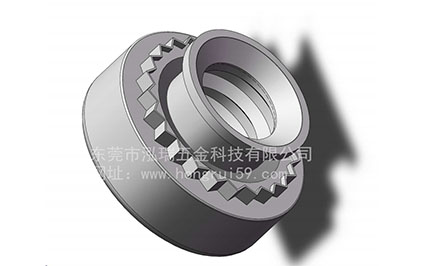Both self clinching nuts and Rivet Nuts are riveting parts, and they are widely used in the field of industrial production. Although their functions are similar, their installation methods and usage scenarios are different. The following will compare rivet nuts and Blind Rivet Nuts to help you better understand them.

1. Differences in installation methods
The installation method of the pressure rivet nut is similar to that of ordinary rivets. It needs to be set on the nut hole by a pressure riveting gun and riveted by pressure. The Blind Rivet Nut needs to be drilled with a drill bit first, and then the blind riveting gun is placed on the rivet, and the blind riveting nut is inserted into the hole by the riveting force of the blind riveting gun, and riveted by the supporting force of the drill bit. Therefore, from the perspective of installation method, pressure rivet nuts are simpler than blind rivet nuts.
2. Different usage scenarios
Clinching nut self clinching fasteners are suitable for installation on plates, dissimilar materials and hard and brittle materials. It can lock the nut quickly and conveniently, while ensuring the firmness and reliability of the riveting. Blind rivet nuts are mainly used for installation on soft and brittle materials, such as plastics, fiberglass, etc., because these materials are relatively fragile. If rivet nuts are used, they may cause damage during installation, but rivet nuts will not.
3. Differences in installation efficiency
The installation speed of the rivet nut is faster than that of the blind rivet nut, because its installation method is simpler. It only needs to be placed on the nut hole, and no chuck or other installation tools are required. The installation of blind rivet nuts is relatively cumbersome. It is necessary to drill holes first, and then use the blind rivet gun in combination with the rivet, which requires higher skills and experience for the operator.
4. Different riveting effects
From the perspective of riveting effect, both pressure rivet nuts and blind rivet nuts have good connection quality and strength. However, in some cases, the connection point of the rivet nut may be loose or not tightened, because the rivet nut sometimes gets stuck at the hole of the plate during the installation process, resulting in incorrect installation. The blind rivet nut is relatively more stable, because it is pulled in as a whole after the nut hole is drilled, so the degree of firmness is higher.
To sum up, pressure rivet nuts and blind rivet nuts are common riveting parts, and they are widely used in different industrial fields. The two are different in terms of installation methods, usage scenarios, installation efficiency and riveting effect, so in practical applications, it is necessary to choose according to the specific situation. We also have flare-in nuts on sale, please contact us if you are interested.